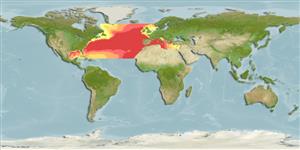Classification / Names
Common names | Synonyms | Catalog of Fishes (gen., sp.) | ITIS | CoL | WoRMS | Cloffa
Actinopterygii (ray-finned fishes) >
Myctophiformes (Lanternfishes) >
Myctophidae (Lanternfishes) > Lampanyctinae
Etymology: Diaphus: Greek, dis, dia = through + Greek, physa, phyo = to beget, to have as offspring (Ref. 45335).
Environment / Climate / Range
Ecology
Marine; bathypelagic; oceanodromous (Ref. 51243); depth range 40 - 2173 m (Ref. 104125). Deep-water, preferred ?; 62°N - 20°N (Ref. 4479)
Eastern Atlantic: British Isles to Mauritania including the Mediterranean and Iceland (Ref. 12462). Western Atlantic: north of the Gulf Stream. Northwest Atlantic: Canada (Ref. 5951). Also reported from the Indian and the Pacific Oceans (Ref. 26165).
Length at first maturity / Size / Weight / Age
Maturity: Lm 5.8 range ? - ? cm
Max length : 9.0 cm SL male/unsexed; (Ref. 4479)
High-oceanic, found between 325-750 m during daytime (Ref. 4479). At night, a two layer system occurs, with adults found at 300-600 m and juveniles at 40-200 m (Ref. 4479).
Life cycle and mating behavior
Maturity | Reproduction | Spawning | Eggs | Fecundity | Larvae
Hulley, P.A., 1990. Myctophidae. p. 398-467. In J.C. Quero, J.C. Hureau, C. Karrer, A. Post and L. Saldanha (eds.) Check-list of the fishes of the eastern tropical Atlantic (CLOFETA). JNICT, Lisbon; SEI; Paris; and UNESCO, Paris. Vol. 1. (Ref. 4479)
IUCN Red List Status (Ref. 115185)
CITES (Ref. 94142)
Not Evaluated
Threat to humans
Harmless
Human uses
More information
Age/SizeGrowthLength-weightLength-lengthLength-frequenciesMorphometricsMorphologyLarvaeLarval dynamicsRecruitmentAbundance
ReferencesAquacultureAquaculture profileStrainsGeneticsAllele frequenciesHeritabilityDiseasesProcessingMass conversion
Tools
Special reports
Download XML
Internet sources
